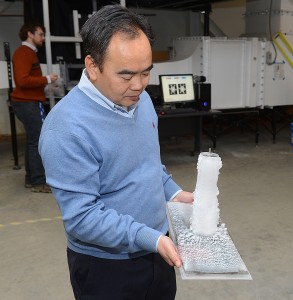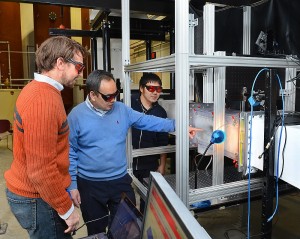
From somewhere back behind the Iowa State University Icing Research Tunnel, Rye Waldman called out to see if Hui Hu was ready for a spray of cold water.
The wind tunnel was down to 10 degrees Fahrenheit. A cylindrical model was in place inside the 10-inch-by-10-inch test section. The wind was blowing through the machine at 60 mph. So yes, said Hu, an Iowa State professor of aerospace engineering, turn on the water.
Waldman, a post-doctoral research associate, hit the controls and three spray nozzles threw a fine mist up into the wind. The tiny water droplets circulated through the tunnel, hit the model and started freezing. Within minutes, the frozen droplets distorted the model’s smooth and regular shape.
That ice is the result of a three-year project to fully refurbish a 20-year-old icing wind tunnel donated to Iowa State by the Goodrich Corp. (now UTC Aerospace Systems). The wind tunnel can operate at minus 20 degrees Fahrenheit with wind speeds as high as 220 mph. It can create everything from frozen fog to wet glaze ice. It has been fully functional for a few weeks.
“We’re trying to understand how the ice builds up on aircraft wings and wind turbine blades,” Hu said. “We want to understand the underlying physics. And when we understand the physics, we can develop better models to simulate and predict when and how ice will build up on cold days.”
Ice can build up “to quite ugly things” that are dangerous and costly, Hu said.
Ice changes the geometry and balance of wings and blades. That can rob aircraft wings of lift and cause crashes. It can reduce the efficiency of wind turbine blades tremendously, cutting the power harvest from winter’s strong winds. It can also throw off the balance of a wind turbine’s spinning blades, putting tremendous forces on shafts and machinery, leading to failures or shut-downs. Thawing ice on turbine blades can also be thrown hundreds of yards, potentially hitting people, buildings or vehicles.
With a better understanding of the icing problems, Hu said engineers could develop better solutions.
Hu said there are only a few icing wind tunnels in the country, and the ISU Icing Research Tunnel is the only one on a university campus.

Hu will use the tunnel as part of a $663,000 grant from NASA to study icing of aircraft wings, part of a $360,000 grant from the National Science Foundation to study icing of wind turbine blades and part of a $20,000 seed grant from Iowa State’s Institute for Physical Research and Technology to develop new technology to study aircraft icing. He’s working on the projects with Alric Rothmayer, an Iowa State professor of aerospace engineering; Kai Zhang, a doctoral student; and Waldman.
They’re using cameras and lasers to take advanced flow measurements, including particle image velocimetry, molecular tagging thermometry and digital image projection.
“In the past, there haven’t been many quantitative experiments to let people see the underlying physics of wing and turbine blade icing,” Hu said. “This is what’s really needed.”
Hu’s experiments, for example, show everything from the thickness of ice as it flows over a wing, the heat transfer of individual water droplets as they freeze, the irregular speed of freezing droplets on a wing or blade and the finger-like patterns of ice formation.
Though they share similar airfoil shapes, Hu said icing on aircraft wings and wind turbine blades can be quite different.
That’s because wings are typically made of metal, have very smooth surfaces and are good heat conductors. Turbine blades are typically a composite such as fiberglass, have rougher surfaces and don’t conduct heat very well. Wings also operate under drier conditions when they’re at altitude; turbine blades near the surface are in the middle of winter sleet and snow.
“All of that makes a huge difference,” Hu said.
So far, most of the data about airfoil icing is related to aircraft.
“But the anti-icing strategies that work for aircraft might not be best for a wind turbine,” he said.
Now that Iowa State’s icing wind tunnel is up and running and looking brand new, Hu said Iowa State engineers will be gathering more and more data about all kinds of icing issues.
February 11, 2014 by Mike Krapfl